Providing the right light will help your Monstera’s growth rate and improve its overall health. In the wild, Monsteras get enough sunlight, plenty of humidity, and lots of nutrients. But indoors, what are a Monstera’s light requirements?
Find out the type of light, the amount and what window location suit your Monstera best.
Monstera Light Requirements
Does Monstera Like Sun or Shade?
Monsteras are rainforest plants, which means they don’t often receive direct sunlight. Therefore, direct light isn’t the best for a Monstera plant. Bright, direct sunlight (i.e., the sun’s rays hitting the leaves directly, casting a shadow) can burn the leaves, leaving on them brown, dry and crispy spots that won’t recover.
Monsteras need indirect sunlight instead, which means they do need the sun to grow (a minimum of 6 hours a day) and can tolerate shade for the rest of day.
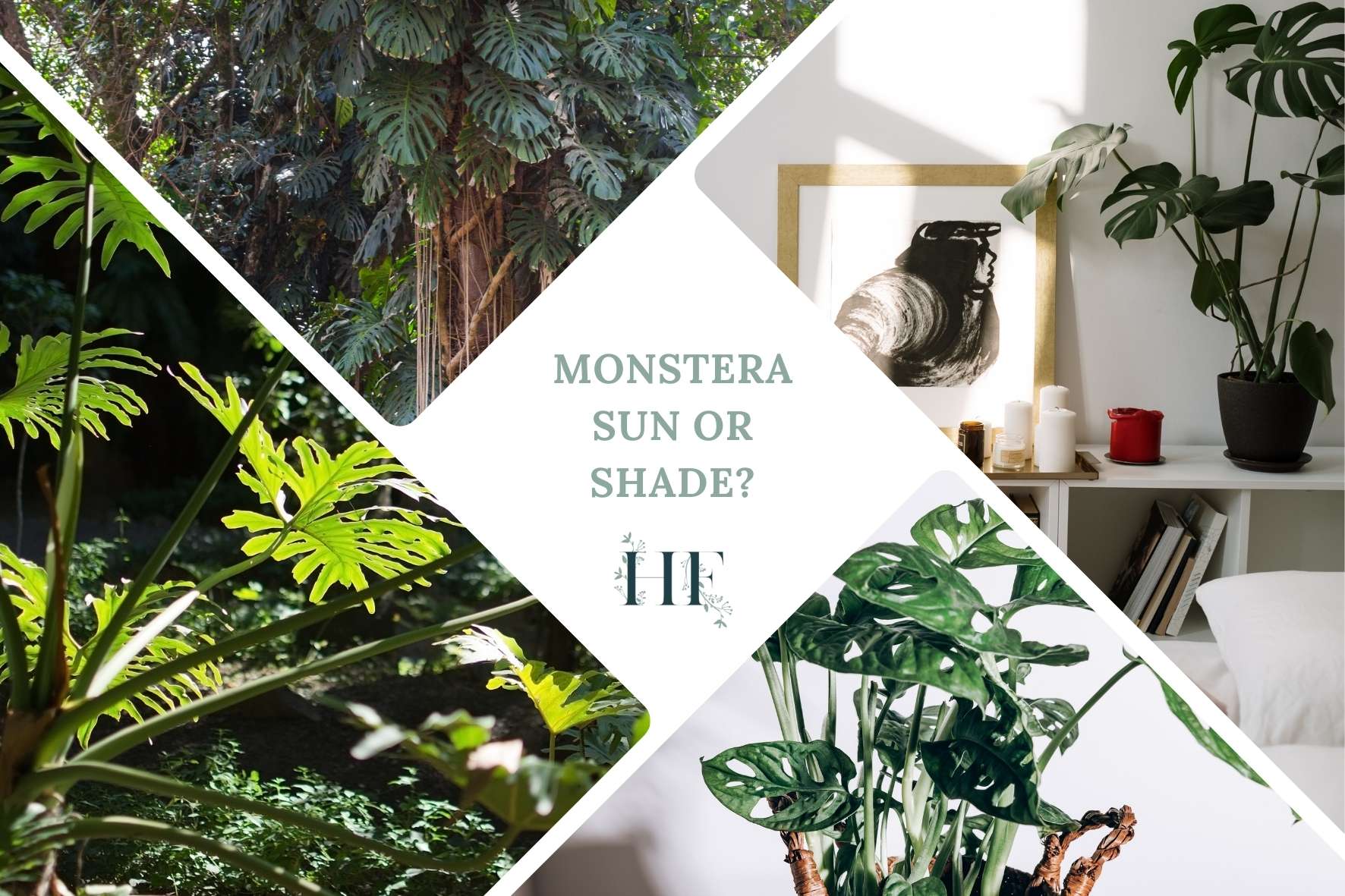
What Is the Best Light Condition for Monsteras?
Monsteras need bright, indirect sunlight for a minimum of six hours a day. Too much sunlight can result in sunburn, resulting in brown and dry leaves. Too little light can slow growth significantly, resulting in yellowing leaves with few-to-no fenestrations.
In their natural habitat, Monsteras grow under the rainforest canopy where they receive the indirect light that penetrates through the canopy.
When grown inside as houseplants, Monsteras will usually thrive near a bright window where the sun’s rays don’t shine directly on the leaves.
Which Windows Are Best for Monsteras?
While Monsteras are tolerant of lower light conditions, which can cause leggy growth among other things, a spot that receives bright indirect light 2 to 4 feet (0.6 to 1.2 m) removed from a southern or eastern facing window is ideal to grow a Monstera.
The location of the window matters due to the type and quantity of light it receives.
- East-facing windows: They face the direction that the sun rises, so they get a lot of bright and somewhat gentle light first thing in the morning. These rays aren’t as harsh as the afternoon ones (west-facing window).
- South-facing windows: They get the most light in the house (if you are in the northern hemisphere), which makes these windows ideal for plants that need a lot of light.
- West-facing windows: They get the strongest and most intense light in the house because the sun reaches its highest point at noon, which is when its rays are the strongest and slowly sets over the west. That’s why west-facing windows can let too much hot direct afternoon light through.
- North-facing windows: They receive the weakest light in the house, which means that they are not bright enough to grow some plants. Also, they usually spend the entire day in the shade. They have low light during the summer and become too dark in the winter.
No matter which window you choose, be careful not to place your Monstera too close to it to avoid exposing it to direct sunlight, which is too intense for these plants. You can check that your Monstera plant doesn’t cast a shadow.
Insider Tip: You can diffuse the light using net curtains or pulling the plant farther back into the room when necessary (for instance, during the summer).
Also, you can move your Monstera plant to a sunnier window during winter (lower light season in Northen hemisphere). For instance, the plants regular spot might be east-facing and then you move it to an west-facing location during winter.
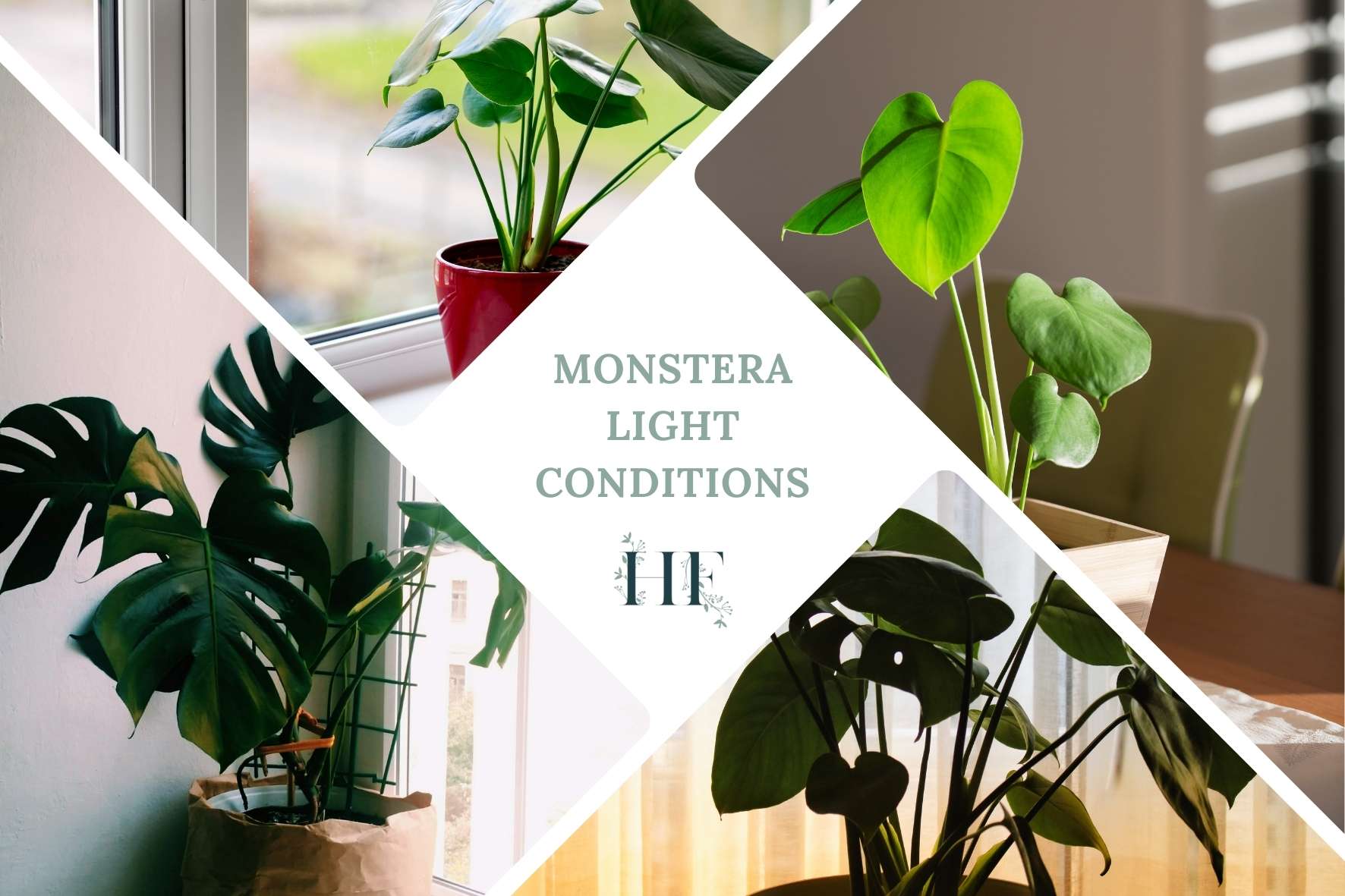
How Much Light Does a Monstera Need?
Typically, Monsteras need between 6 to 8 hours of bright indirect light a day to thrive.
Do Variegated Monsteras Need More Light?
Variegated Monstera light needs are higher than regular Monstera’s. They require more light to achieve the same growth rate as a regular Monstera.
Variegated Monstera varieties like the Thai Constellation or Monstera Deliciosa Variegata need more light because the variegated portions of the leaves do not photosynthesize. The variegated tissue consumes the plant’s energy without producing any in return.
While they look beautiful, a variegated Monstera with large amounts of sectoral variegation (like the half-moon pattern, for instance,) will need even more light.
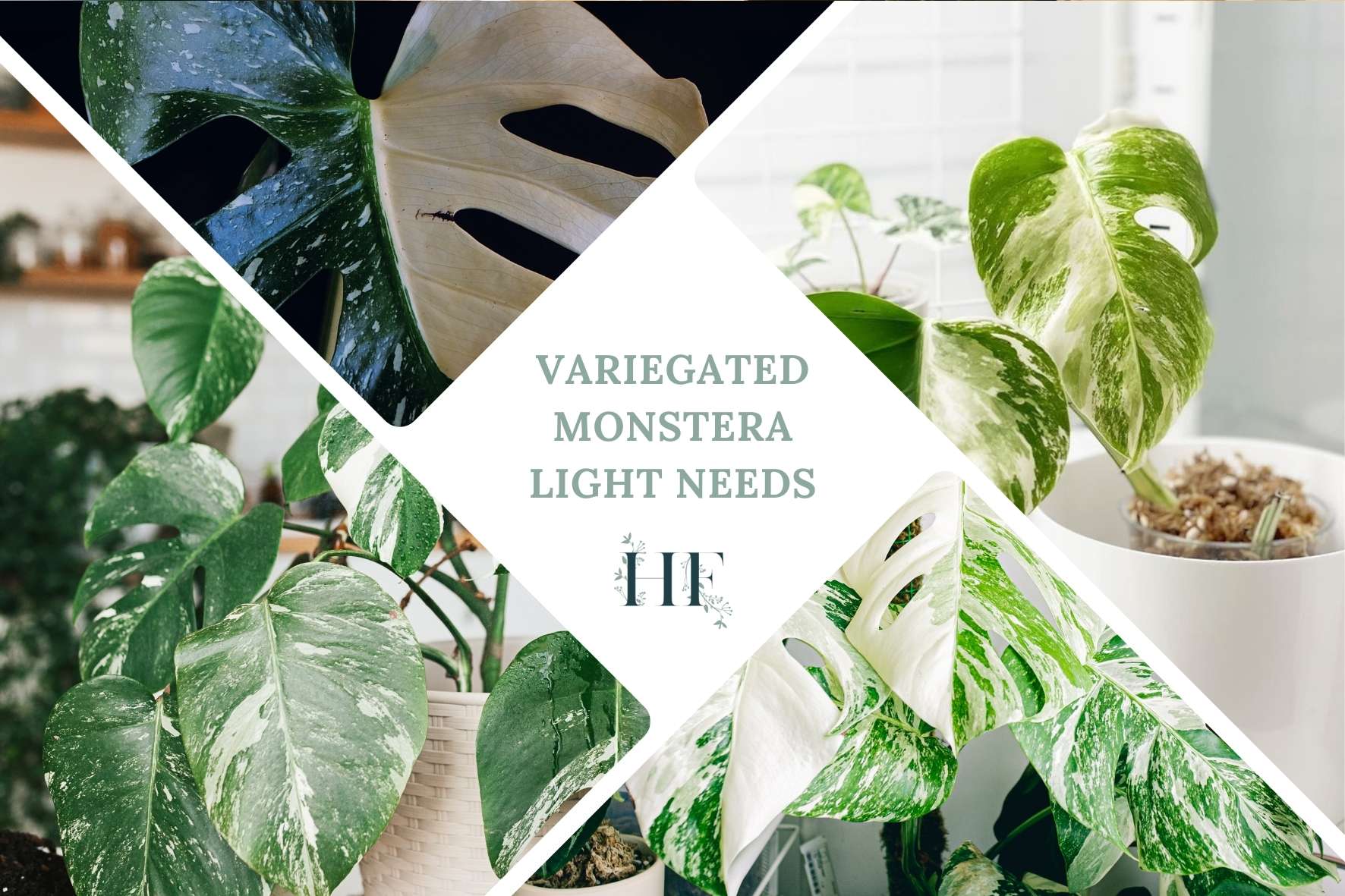
How Do You Know If Your Monstera Is Getting Enough Light?
Monstera can survive in low light but it needs bright indirect light to thrive. However, it can be hard to tell what “bright” means exactly.
Light for plants is measured in two ways: light intensity and light duration.
Light intensity refers to how bright the light is while light duration refers to how long your plant is exposed to sunlight. Both the intensity and duration of light are important to growing healthy Monstera plants.
Light Intensity
You can estimate the light levels of natural light based on visible shadows.
- Bright direct light: Also referred to as direct sunlight or full sun, it feels warm on your skin, and the shadows are crisp with high contrast between dark and light. This means that the sun’s rays shine directly on the foliage of your Monstera.
- Bright indirect light: It has less difference between shadows and light, but the border is still clear. The area around your Monstera plant is brightly lit, but the plant doesn’t receive direct sunlight.
- Medium indirect light: It casts a moderate shadow with a fuzzy outline. Your Monstera receives some light but it isn’t direct sunlight.
- Low indirect light: It has a faint and blurry shadow. This means that very little natural light reaches your Monstera.
The intensity of light is measured in units called foot candles. According to the University of Arkansas Agricultural Division study (source), Monstera Deliciosa light requirements are a minimum of 75 to 100-foot candles and a preferred level of 200 to 500-foot candles.
To put those numbers in perspective, direct sunlight outdoors and on a cloudless day can be up to 10,000 foot candles.
Light Duration
The duration of light refers to the amount of time your plant receives sunlight or natural light each day. This is typically measured in hours.
However, the number of hours of light exposure don’t need to be consecutive. Also, not all light is the same. For example, bright indirect light from a southern window will provide your Monstera with more sunlight than an equal amount of light from a northern window.
So, how do you know if your Monstera is getting enough light?
You can make sure that your Monstera is getting enough light by measuring the light levels.
You can avoid the guesswork and buy a light meter. This device will tell you the exact light measurement in foot candles. This information will help you choose the best spot for your Monstera and other houseplants.
The one I recommend is Dr.Meter Digital Light Meter.

Is My Monstera Getting Too Much Light?
Apart from measuring the light levels, your Monstera can tell you if it’s receiving too much light exposure.
Signs your Monstera is getting too much light include:
- Brown leaves: Monstera leaves will burn if they are exposed to direct sunlight, resulting in dry, crispy brown spots in their leaves and leaf tips. Sunburn causes permanent damage to a plant.
- Dry soil: Direct sunlight can cause the actual pot to overheat, also causing the soil to dry excessively. This causes stress to your Monstera as it needs evenly moist soil to thrive.
- Lack of humidity: Direct sunlight doesn’t just dry out the soil, it dries out the air too. Placing your Monstera in direct sunlight affects the humidity levels of your Monstera, lowering them considerably.
If you spot these signs, consider moving your Monstera to a more favourable location and avoid direct sunlight at all costs.

Can Monsteras Live in Low Light?
Monsteras can survive in low light, but they won’t grow to their full potential and stay healthy. Monsteras need enough light for healthy leaf growth, to develop their beautiful fenestrations, and to create striking variegated leaves.
You can still grow a Monstera in a home without a lot of natural light, just don’t expect your Monstera Deliciosa to get huge.
If you are wondering whether your monstera isn’t getting enough light, there are some telltale signs to keep an eye on.
Signs your Monstera needs more light include:
- Leggy growth: A monstera plant grown in low light conditions will show signs of leggy growth. A leggy Monstera’s stems elongate, leaving a wider space between leaves as the plant attempts to stretch towards the light. This will leave your Monstera looking sparse.
- Weak aerial roots: Aerial roots need good lighting conditions for healthy growth. Too little light can compromise their development, resulting in weak aerial roots that have a lower ability to climb.
- Small leaves: If your Monstera is too far from its light source or the light conditions are too low it will likely produce smaller leaves.
- Lack of holes and splits: Monsteras also need good lighting in order to produce fenestrated leaves. Monstera leaves regularly develop splits and holes as the plant matures. Keeping your plant in low-light conditions can prevent it from maturing and producing the dramatic holes and splits it’s known for.
- Slow growth: Low light will affect your Monstera’s growth rate. Although slow growth is natural during its dormant period (autumn and winter months), afterwards Monstera should enter its active growth season. Low light conditions will decrease its growth even during the spring and summer months.
- Lack of variegation: Variegated varieties of Monstera need even more light than regular Monsteras. So, without enough light, a variegated Monstera will be producing more green leaves instead of variegated ones since it doesn’t have enough energy to do so.
- Constantly moist soil: Sunlight helps your Monstera use water efficiently, but in dark conditions, the soil can stay wet for far longer than is healthy for the roots, even causing root rot.
- Yellow leaves: Lack of light can also cause leaf discolouration. Both overwatering and underwatering can cause yellow leaves, but lack of sunlight can also be the reason behind it.
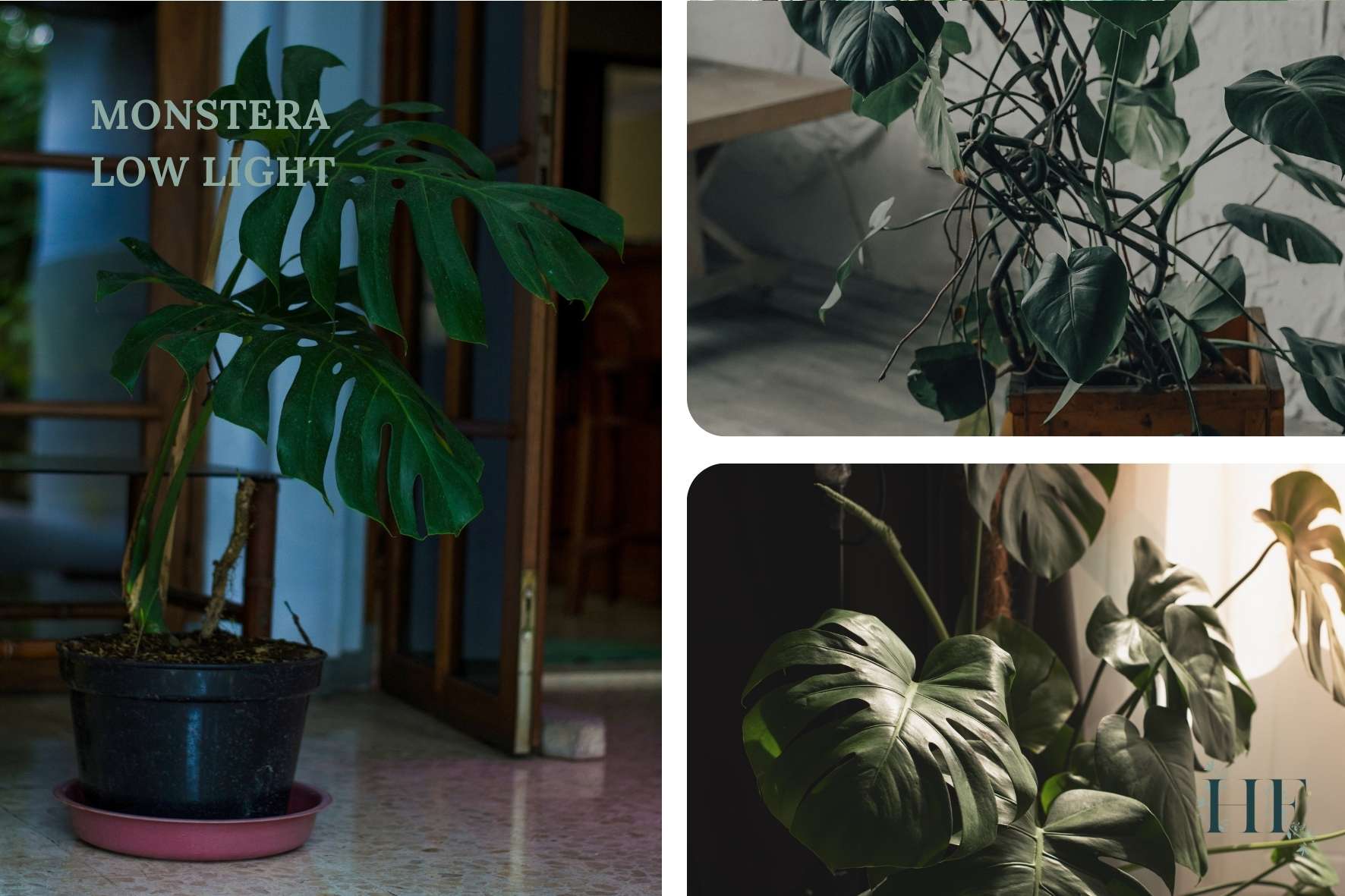
Monstera Under Grow Light
Although some Monsteras can grow in relatively low light, it doesn’t mean they will be thriving.
When it’s not possible to provide enough natural sunlight to your houseplants, you can supplement your Monstera’s light needs with grow lights. This way, you will allow your Monstera to continue to photosynthesize despite having limited access to natural sunlight.
They are especially useful in winter too, since your Monstera probably won’t be getting enough light and will be in need of an extra boost.
Grow lights come in different styles and can accommodate a whole host of sizes and space limitations. So, you won’t have to compromise aesthetics or functionality to provide enough light to your Monstera.
This full-spectrum grow light comes with a timer and you can clip it to a shelf. If you already have a lamp, you can get a Sansi bulb, which is affordable and does a good job too.
Insider Tip: Grow lights must be a full-spectrum fluorescent lights since the regular incandescent bulbs don’t emit the quality of light these plants need to photosynthesize.
Also, pay attention to the distance between the plant and the artificial light source. The light system should provide you with some guidelines for this. Make sure to follow those instructions, because grow lights can also burn leaves (just as the sun can).
Finally, remember that artificial lights produce heat and heat affects the humidity levels of your plant.

You can grow a big, healthy Monstera no matter what light conditions you have to work with. The trick is to make your space work for you and to know when your Monstera is asking for more light!

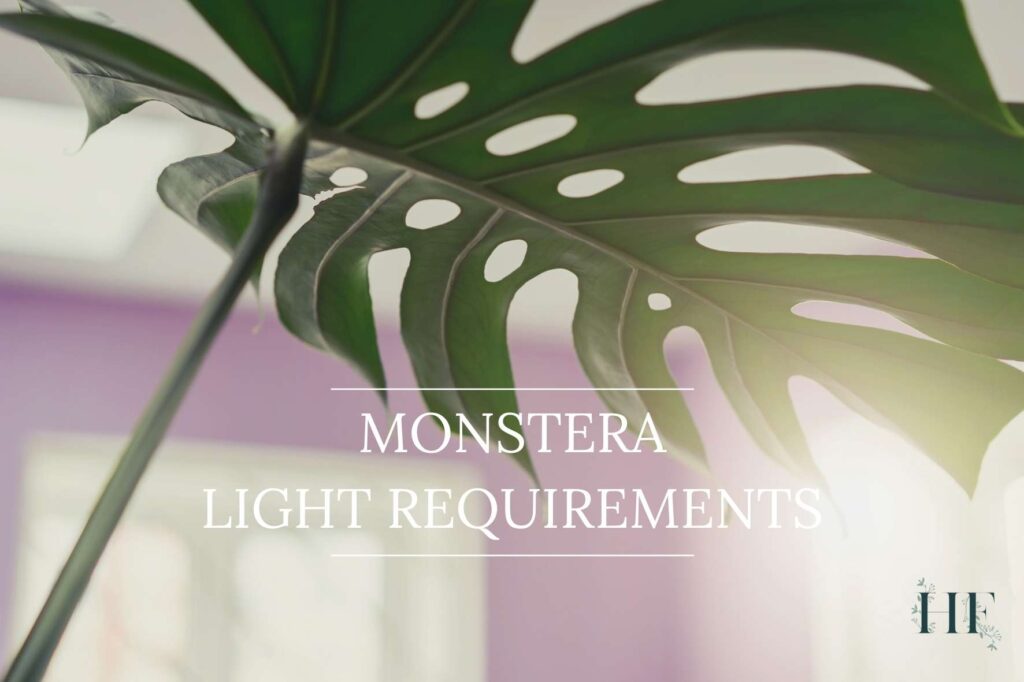
There is an extremely important variable that was not discussed in this post and that is how the plant's needs for light change depending on its maturity level. You recommend 200-500 fc which is fine for a small plant but, if you want your plant to get big, it'll need a lot more. My largest Monstera is getting close to mature and I'm giving it about 5000 fc 12h/day and it's doing great, its leaves are 2.5 foot long and super fenestrated.
Also, fc is not a helpful unit when it comes to plants. PAR/PPFD is the industry standard because it measures the light that is actually usable by the plant, hence why the conversion of fc to PAR/PPFD is a messy business because the ratio changes greatly depending on the light spectrum. This is why serious grow light sellers always include PAR/PPFD readings at various distances in their product details.